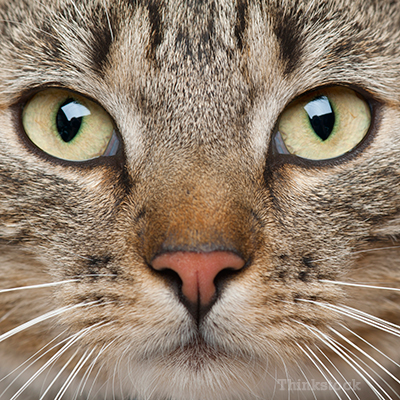
Progressive retinal atrophy (PRA) is a degenerative disorder of the retina. In case you’re a little rusty with your eye anatomy, the retina is the light-gathering tissue inside the eye that acts like the film in a camera. PRA leads to degeneration of the retinalphotoreceptors (the cells in the retina reactive to light). In cats, PRA can be either inherited or acquired.
Inherited progressive retinal atrophy
In cats, 2 different genes have been identified as causes of PRA:
- CEP290 is a gene that encodes for a protein known as centrosomal protein 290 kDa. This protein maintains the important structure known as the cilium in rod photoreceptors. Progressive retinal atrophy caused
 by CEP290 is autosomal recessive, meaning that in order for an animal to be affected, that animal needs to have inherited two mutated genes. Animals that have one mutated gene are unaffected, but are carriers and can transmit the disease. Progressive retinal atrophy, secondary to CEP290, is more common in certain breeds, such as the Abyssinian, Somali, and Ocicat. In addition, mutations of CEP290 have been found in other breeds, such as the American Curl, American Wirehair, Bengal, Balinese/Javanese, Colorpoint Shorthair, Cornish Rex, Munchkin, Oriental Shorthair, Peterbald, Siamese, Singapura, and Tonkinese.
by CEP290 is autosomal recessive, meaning that in order for an animal to be affected, that animal needs to have inherited two mutated genes. Animals that have one mutated gene are unaffected, but are carriers and can transmit the disease. Progressive retinal atrophy, secondary to CEP290, is more common in certain breeds, such as the Abyssinian, Somali, and Ocicat. In addition, mutations of CEP290 have been found in other breeds, such as the American Curl, American Wirehair, Bengal, Balinese/Javanese, Colorpoint Shorthair, Cornish Rex, Munchkin, Oriental Shorthair, Peterbald, Siamese, Singapura, and Tonkinese.
- CRX (also found in Abyssinian and Somali cats) encodes for a transcription factor critical for the development of the retina. Unlike CEP290, mutations in CRX gene cause autosomal dominant progressive retinal atrophy in cats. In order for an animal to be affected, it only has to inherit one mutated gene. As a result, autosomal dominant PRA is usually present across many generations since offspring of an affected parent have a 50% chance of inheriting the mutated gene.
Toxicity causing progressive retinal atrophy
Exposure to certain antibiotics has been associated with progressive retinal atrophy in cats:
Fluoroquinolone enrofloxacin was first reported to cause PRA in cats, especially when used in higher doses and for longer periods of time. Fortunately, the incidence of enrofloxacin-associated PRA has decreased since the recommended dose was lowered to 5 mg/kg/day. Testing of the related antibiotic orbifloxacin has also been reported to cause PRA at higher doses. If fluoroquinolone-associated PRA is suspected, the antibiotic should be discontinued immediately to avoid additional damage to the retina. Before starting treatment with these antibiotics, talk with your veterinarian about the risk of PRA.
Nutritional deficiency causing progressive retinal atrophy
Cats can also develop vision loss if their diet is deficient in the amino acid taurine. PRA secondary to taurine deficiency starts in the central portion of the retina. As a result, cats with taurine-deficiency PRA have difficulty seeing with their central vision but their peripheral vision is intact. Taurine-deficiency can occur if a cat is being fed a diet not specifically formulated for cats, such as dog food or a homemade diet. Fortunately, taurine-deficiency PRA advances slowly and switching to the right diet can halt progression.
Diagnosis of progressive retinal atrophy
If it looks like your cat is having trouble seeing, you should take her to the veterinarian as soon as possible. Your veterinarian can usually diagnose PRA based on the appearance of your cat’s retina. Electroretinography or genetic testing may be ordered to confirm the diagnosis.
as soon as possible. Your veterinarian can usually diagnose PRA based on the appearance of your cat’s retina. Electroretinography or genetic testing may be ordered to confirm the diagnosis.
Treatment of progressive retinal atrophy
Unfortunately, there is no treatment for PRA due to a genetic mutation. However, scientists have identified 2 of the genes that cause PRA in cats, allowing breeders of predisposed breeds to check their breeding stock with these genetic tests. For fluoroquinolone-associated PRA, it is important to discontinue the antibiotic as soon as possible to avoid additional damage to the retina. With taurine-deficiency PRA, correcting the nutritional deficiency promptly stops the progression.
Living with progressive retinal atrophy
It’s important for people to understand that cats can adjust remarkably well to living with PRA. Unlike people, cats don’t need to drive or read and they spend most of their time in one place. As a result, cats become familiar with the layout of their house and can get around easily by memory. However, there are a few things you need to know if you are living with a blind cat:
- Try not to rearrange furniture
- Keep blind cats away from pools and balconies without barriers
I have personal experience with feline progressive retinal atrophy (2 of my cats have had it). Both cats lived long happy lives. Most people who met my cats didn't even realize they were blind and were amazed to see them maneuver around my house and even jump onto the furniture.
If you have any questions or concerns, you should always visit or call your veterinarian -- they are your best resource to ensure the health and well-being of your pets.
